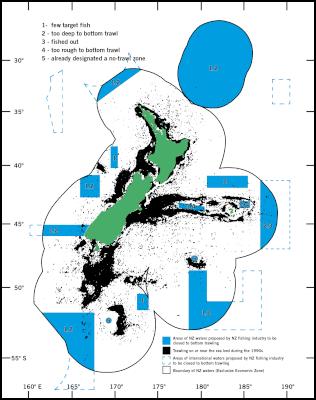Greenpeace Releases Map that shows Trawling
Closure Areas Unscientific

Wednesday, 16 August 2006:* The New Zealand fishing industry's proposal to close some areas of the sea around New Zealand to bottom trawling does little to stop the destruction of vulnerable deep-sea life threatened by the practice, a map released by Greenpeace shows.
Greenpeace has taken a Ministry of Fisheries 'trawling map' which shows where the fishing industry has been bottom trawling (1), and overlaid it over the fishing industry's map of its proposed closures (2).
The map shows that most areas proposed for closure are either too deep or too rough to bottom trawl, or are otherwise of no interest to the fishing industry because they don't have enough bottom-trawled target fish, such as orange roughy, to be economical as fishing areas.
The Greenpeace map coincides with the recent publication of a NIWA report, commissioned by the Department of Conservation, which also criticises the fishing industry closure proposal and says that, under the proposal: · protection for endemic species protection would be very low · "…despite their large geographic area, the focus of this proposal on existing areas that have both very low fishing value and low fish diversity, makes it a poor option for the long-term protection of demersal fish diversity in New Zealand's EEZ."
"But as Fisheries Minister Jim Anderton has repeatedly stressed, decisions about areas closed to bottom trawling need to be based on science. Greenpeace welcomes science-based industry initiatives to close areas to bottom trawling too. But now we have the scientists and their maps saying that this proposal to close one-third of New Zealand waters to bottom trawling does nothing to protect what's being destroyed," said Hagler.
The industry's approach of volunteering to close some of New Zealand waters to bottom trawling is also being promoted as a way of protecting vulnerable deep-sea life found in international waters, where the use of the destructive fishing practice is increasing worldwide.
"Unfortunately, there is even less science about deep sea life in international waters than within New Zealand waters. That's why we are urging New Zealand to support a United Nations moratorium on bottom trawling in international waters in November. It will keep out bottom trawlers until scientists research which areas need permanent protection, and governments work out the ways and means to protect them."
Momentum is building internationally, with a band of Pacific nations, the UK, Chile, Brazil, Germany, Indonesia, Denmark and Sweden, among many others, leading progress internationally towards November's vote on a bottom trawling moratorium in international waters at the UN.
"New Zealand needs to stand with these leading countries at the UN and help bring other countries onboard", concluded Hagler.
1) "Trawling on or near the sea bed during the 1990s," Ministry of Fisheries, (1) "Trawling on or near the sea bed during the 1990s," Ministry of Fisheries, http://www.fish.govt.nz/en-nz/Environmental/default.htm
(2) http://www.seafood.co.nz/newscentre/press/2006pressreleases/closures.asp
ENDS



 Gordon Campbell: On The Public Sector Carnage, And Misogyny As Terrorism
Gordon Campbell: On The Public Sector Carnage, And Misogyny As Terrorism National Maori Authority: Maori Authority Warns Government On Fast Track Legislation
National Maori Authority: Maori Authority Warns Government On Fast Track Legislation NZ Government: Comprehensive Partnership The Goal For NZ And The Philippines
NZ Government: Comprehensive Partnership The Goal For NZ And The Philippines DoC: Canterbury Spotted Skink In Serious Trouble
DoC: Canterbury Spotted Skink In Serious Trouble Te Pāti Māori: Oranga Tamariki Cuts Commit Tamariki To State Abuse
Te Pāti Māori: Oranga Tamariki Cuts Commit Tamariki To State Abuse NZCTU: Inflation Data Shows Need For A Plan On Climate And Population
NZCTU: Inflation Data Shows Need For A Plan On Climate And Population Statistics New Zealand: Annual Inflation At 4.0 Percent
Statistics New Zealand: Annual Inflation At 4.0 Percent


